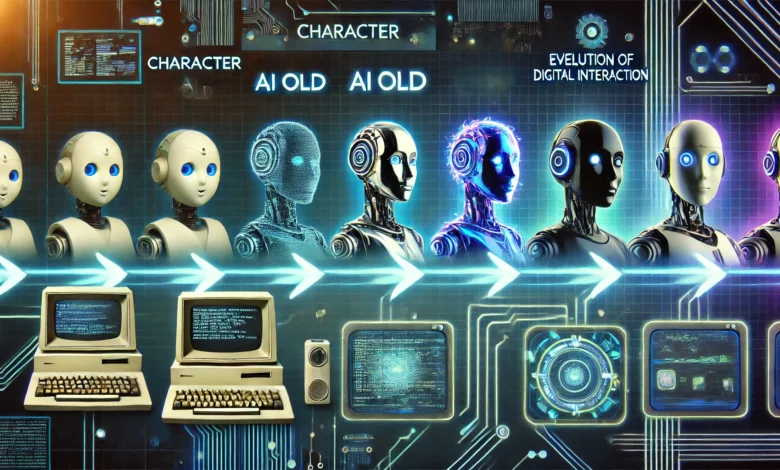Character AI Old: The Journey from Simple Scripts to Advanced Digital Companions

Technology has changed the way people interact with digital systems, and one of the most significant advancements is the development of interactive characters. The concept of character ai old has been evolving for decades, starting from basic text-based systems to advanced conversational models capable of realistic interactions. This article explores the history, major advancements, ethical concerns, and future possibilities of character ai old, highlighting its impact on human-computer interaction.
The Early Development of Interactive Digital Characters
The Birth of Digital Interaction
The idea of interactive digital characters dates back to the 1960s when researchers started experimenting with basic conversational systems. One of the earliest and most well-known programs was ELIZA, created by Joseph Weizenbaum at MIT. ELIZA was designed to simulate human conversation by responding to user input with pre-programmed statements. It worked by recognizing specific keywords and generating responses based on a script, creating the illusion of understanding.
Although ELIZA was limited in functionality, it was a groundbreaking development that demonstrated the potential for digital interaction. It laid the foundation for further advancements in the field, leading to more complex and adaptive digital characters.
The Growth of Early Interactive Programs
Following ELIZA, other digital interaction programs emerged, aiming to enhance conversational abilities. However, these early programs were still heavily dependent on scripted responses and lacked the ability to understand context or learn from interactions.
During the late 20th century, researchers continued to experiment with language processing models, gradually improving their ability to analyze text and generate relevant responses. This period marked the transition from rigid, rule-based systems to more flexible models that could handle a wider range of user inputs.
Evolution and Technological Advancements
The Role of Machine Learning in Character AI Old
A major breakthrough in digital character interaction came with the introduction of machine learning and natural language processing. Unlike their predecessors, newer models could analyze input, understand context, and generate responses that felt more natural. These advancements allowed digital characters to move beyond simple question-and-answer formats and engage in meaningful conversations.
By using large datasets to train language models, developers enabled interactive characters to adapt to different conversational styles and provide more personalized interactions. This shift significantly improved the realism and usability of digital characters in various applications.
The Rise of Modern Interactive Characters
In recent years, character ai old has become more advanced, with platforms dedicated to creating and customizing digital characters. These modern characters are capable of remembering past interactions, maintaining consistent personality traits, and engaging in complex discussions. Unlike older models, they can adapt to user behavior and provide more dynamic interactions.
The ability to customize digital characters according to specific themes and preferences has contributed to their growing popularity. Many users engage with them for entertainment, companionship, or assistance with tasks, further expanding their role in daily life.
Ethical Concerns and Challenges
The Spread of Misinformation and Manipulation
One of the biggest concerns regarding character ai old is the potential for misuse. Since these digital characters generate responses based on data, there is a risk of them spreading misinformation or being used for manipulation. This has raised ethical questions about how they should be regulated and monitored.
To address these concerns, developers must implement safeguards to prevent the misuse of digital characters and ensure transparency in how they function.
The Impact on Human Interaction
There is ongoing debate about the effect of interactive digital characters on human relationships. While they provide companionship and assistance, some fear that excessive reliance on them may reduce face-to-face interactions and weaken social skills.
As digital characters become more sophisticated, it is essential to strike a balance between technological interaction and real-world human engagement. Encouraging responsible use can help mitigate potential negative effects.
The Need for Ethical Development
To maintain ethical standards, developers must prioritize responsible AI development. This includes ensuring that digital characters are designed to be transparent, unbiased, and aligned with ethical guidelines. Clear policies on their use and behavior can help prevent potential harm and ensure that they remain beneficial to users.
Future Possibilities of Character AI Old
Enhancing Context Awareness and Emotional Intelligence
As technology advances, the future of character ai old will likely focus on improving contextual awareness and emotional intelligence. This means that digital characters will be able to recognize emotions, understand tone, and respond in a more natural and empathetic way.
Such advancements could make digital characters even more engaging, opening up new possibilities for applications in fields such as mental health support, customer service, and personal companionship.
Integration with Virtual and Augmented Reality
One of the most exciting possibilities is the integration of interactive digital characters into virtual and augmented reality environments. By combining conversational abilities with immersive digital spaces, users could experience more realistic and interactive engagements.
This could revolutionize education, gaming, and entertainment, allowing users to interact with digital characters in fully immersive environments.
Expanding Applications in Various Industries
As character ai old continues to evolve, its applications are expected to expand across multiple industries. In education, digital characters could serve as tutors, providing personalized learning experiences. In healthcare, they could assist in therapy sessions by engaging patients in meaningful conversations. In business, they could enhance customer support by providing instant, context-aware assistance.
The potential applications of interactive digital characters are vast, and as technology continues to develop, their impact on various industries will likely grow.
Conclusion
The evolution of character ai old highlights the remarkable progress made in digital interaction. From early text-based systems like ELIZA to modern adaptive models, interactive digital characters have come a long way. Advancements in machine learning and natural language processing have significantly improved their capabilities, making them more engaging and realistic.
While ethical challenges exist, responsible development and transparent guidelines can ensure that digital characters remain beneficial to users. Looking ahead, the integration of these characters into immersive environments and their expansion into various industries will further shape the future of digital interaction.
Frequently Asked Questions
1. What was the first interactive digital character?
The first widely recognized digital character was ELIZA, developed in the 1960s. It was designed to simulate human conversation using pattern-matching techniques.
2. How has character ai old evolved over time?
It has evolved from simple, script-based programs to advanced models capable of engaging in complex and dynamic conversations. Improvements in machine learning and natural language processing have played a key role in this transformation.
3. What are the ethical concerns related to interactive digital characters?
Some ethical concerns include the spread of misinformation, reduced human interaction, and the potential for manipulation. Responsible development and transparency are crucial in addressing these issues.
4. How are interactive digital characters used today?
They are used in entertainment, education, customer service, and mental health support. Some users also engage with them for companionship and assistance with tasks.
5. What does the future hold for character ai old?
The future may include improved contextual awareness, emotional intelligence, and integration with virtual reality. These advancements could further enhance their applications in various fields.



